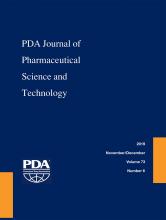Abstract
Low pH inactivation of enveloped viruses has historically been shown to be an effective viral inactivation step in biopharmaceutical manufacturing. To date, most statistical analyses supporting modular low pH viral inactivation claims have used descriptive statistical analyses, which in many cases do not allow for probabilistic characterization of future experimental log10 reduction values (LRVs). Using Bayesian hierarchical logistic regression modeling, probability statements regarding the likelihood of successful low pH viral inactivation based on only certain process parameter settings can be derived. This type of analysis also permits statistical modeling in the presence of historical data from different experiments and right-censored data, two issues that have not as yet been satisfactorily dealt with in the literature. The characterization of the probability of successful inactivation allows creation of a modular claim stating future LRVs will be greater than or equal to some critical value, based on only certain process parameter settings of the viral inactivation unit operation. This risk-based approach, when used in conjunction with traditional descriptive statistics, facilitates coherent and cogent decision-making about modular viral clearance LRV claims.
LAY ABSTRACT: Viral contamination of biologically derived drug products is a safety concern for both regulatory agencies and drug manufacturers. Validation of the removal and inactivation of model viruses is required to ensure the safety of patients receiving these drugs, and dedicated steps, including viral filtration and chemical inactivation, are often added to manufacturing processes to provide additional clearance and inactivation capabilities. One of these steps, low pH inactivation, exposes enveloped viruses to a low pH environment to reduce the potential of the virus to infect host cells. Because the viral inactivation capability of this well-understood unit operation has been demonstrated for years across many different biological drugs, many companies have begun investigating the use of the modular viral clearance claim for the low pH inactivation step. Modular claims ensure, without experimentation, that a certain level of reduction of virus will occur if specific parameters are used in the manufacturing process, allowing manufacturers to save both time and resources in the early developmental phases of biologically derived drugs. A novel type of statistical analysis is outlined in this article that when used in addition to previously used analyses allows drug manufacturers to estimate a more valid level of virus reduction in modular viral clearance claims.
- Viral inactivation
- Modular viral clearance
- Modular claim
- Generic claim
- Low pH inactivation
- Viral clearance
- Log reduction value (LRV)
- Murine leukemia virus (MuLV)
- Retrovirus
- Viral safety
- © PDA, Inc. 2019
PDA members receive access to all articles published in the current year and previous volume year. Institutional subscribers received access to all content. Log in below to receive access to this article if you are either of these.
If you are neither or you are a PDA member trying to access an article outside of your membership license, then you must purchase access to this article (below). If you do not have a username or password for JPST, you will be required to create an account prior to purchasing.
Full issue PDFs are for PDA members only.
Note to pda.org users
The PDA and PDA bookstore websites (www.pda.org and www.pda.org/bookstore) are separate websites from the PDA JPST website. When you first join PDA, your initial UserID and Password are sent to HighWirePress to create your PDA JPST account. Subsequent UserrID and Password changes required at the PDA websites will not pass on to PDA JPST and vice versa. If you forget your PDA JPST UserID and/or Password, you can request help to retrieve UserID and reset Password below.






